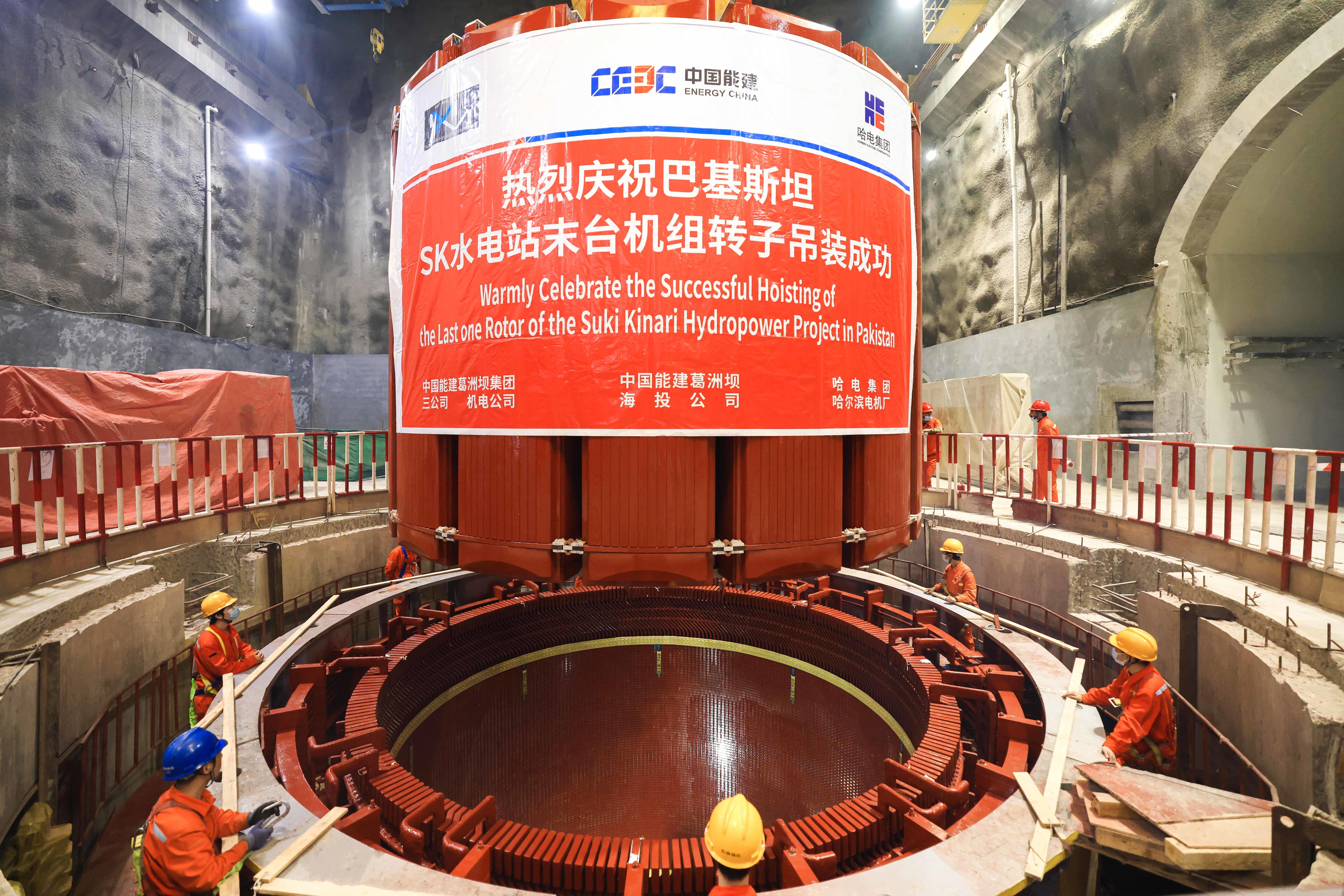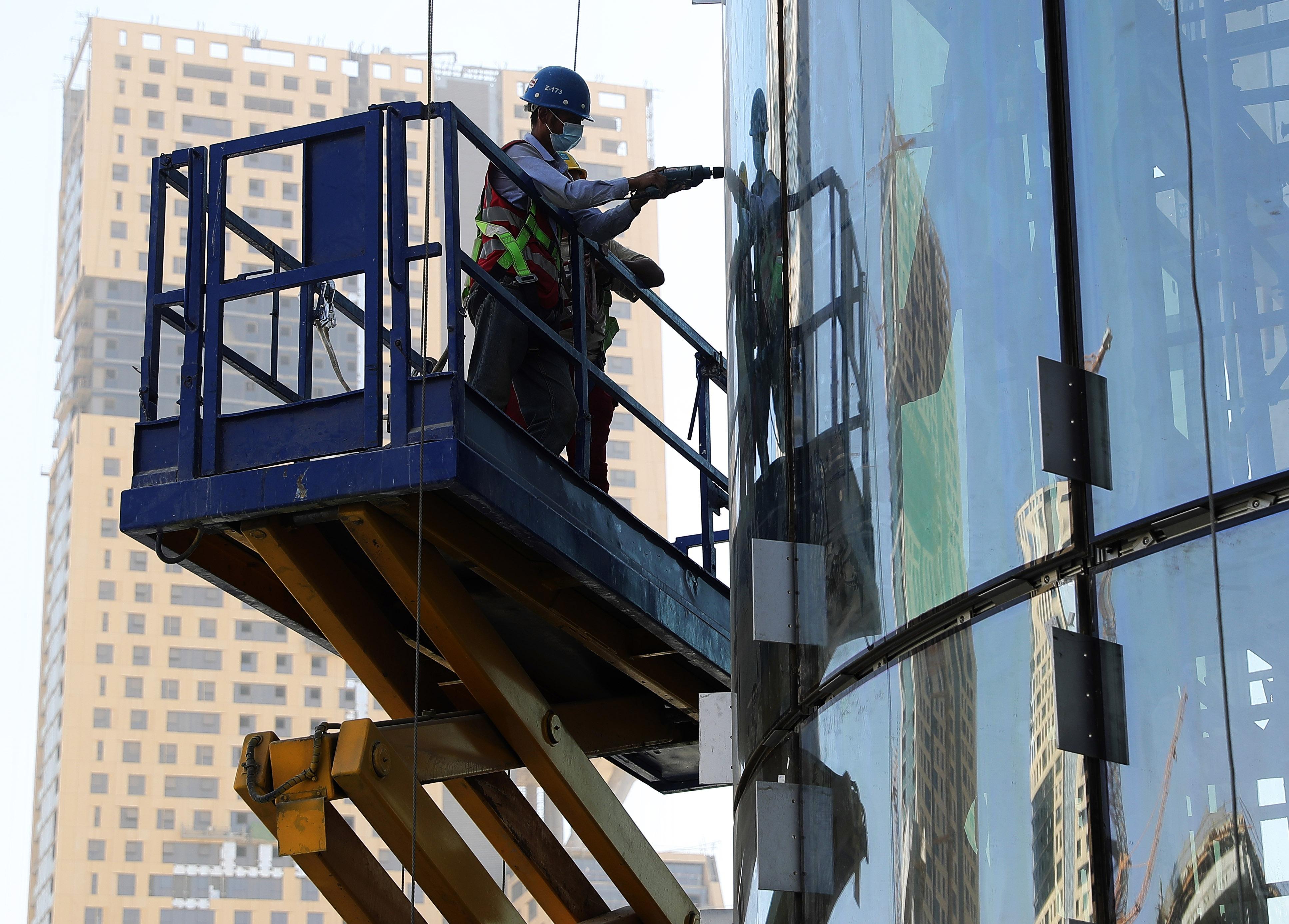Chinese builders strive to deliver transformative projects to BRI countries, regions
 The last rotor of a hydropower unit constructed by China Gezhouba Group Co Ltd is hoisted in Pakistan in June. (PHOTO / XINHUA)
The last rotor of a hydropower unit constructed by China Gezhouba Group Co Ltd is hoisted in Pakistan in June. (PHOTO / XINHUA)
China's State-owned enterprises are actively building eco-friendly infrastructure projects in economies involved in the Belt and Road Initiative to enhance their development resilience and achieve green growth, market watchers and business executives have said.
Chinese SOEs, which have tremendous experience in technology accumulation and practices in the domestic market, are capable of spearheading these transformational projects, which include onshore and offshore wind power units, photovoltaic power stations, pumped storage power plants and sewage treatment facilities, they said, acknowledging the importance of sustainability and environmental stewardship.
These firms are leveraging their capabilities to explore and implement eco-friendly infrastructure solutions, which not only reduce the carbon footprint, but also promote sustainable development.
Jiang Yu, a researcher at the Development Research Center of the State Council
"These firms are leveraging their capabilities to explore and implement eco-friendly infrastructure solutions, which not only reduce their carbon footprint, but also promote sustainable development," said Jiang Yu, a researcher at the Development Research Center of the State Council.
Such moves, he said, are aimed at maximizing energy efficiency, minimizing waste and adopting renewable energy sources wherever possible across the world, particularly in countries and regions participating in the BRI.
China has notable advantages in the field of new energy, making it a valuable partner in assisting developing and least-developed countries in establishing diverse renewable energy projects, said Ryad Mezzour, Moroccan minister of industry and trade.
These initiatives encompass a wide range of solutions, such as solar power plants, wind farms and hydropower units.
By collaborating with China, several countries have the opportunity to leverage Chinese expertise in the renewable energy sector. Such partnerships hold potential in not only improving the quality of life for residents in many countries, but also in enhancing energy security, said Huang Qunhui, director of the Institute of Economics at the Chinese Academy of Social Sciences in Beijing.
For instance, China Gezhouba Group Co Ltd, a subsidiary of State-owned China Energy Engineering Corp, said in July that it had started building the main section of the Upper Cisokan pumped storage power plant in West Java, Indonesia.
As one of the landmark projects of China Energy under the BRI, it is aimed at the energy transformation of Indonesia and helping its government achieve a target of renewable energy accounting for 23 percent of its total energy mix by 2025.
Once completed, the plant will have an installed capacity of 1,040 megawatts, supplying 147.9 million kilowatt-hours of green power to the Java-Bali grid annually, said Sun Changzhong, vice-president of China Gezhouba Group's international business unit. It will also greatly enhance peak-shaving capacity and power grid stability in the region, he added.
The Dubai Shindagha Corniche Viaduct Project in the United Arab Emirates, which has 24 continuous girder bridges in its main structure, was completed by China State Construction Engineering Corp (Middle East) LLC, a subsidiary of China State Construction Engineering Corp, last year. Among these, three are cast-in-place continuous box girders, and 21 are prefabricated segmental assembly bridges, totaling 1,901 segments.
The project adopts bridge erection with "short-line segmental beam prefabrication and assembly "green construction technology, the Beijing-based CSCEC said in a statement in July.
The new traffic corridor connects the new and old urban areas of Dubai, shortening the average commute time in the Shindagha area to 16 minutes from 110 minutes previously.
It also alleviates traffic congestion in the old urban areas of Dubai, improves travel convenience for residents, and supports the high-quality development of regional cities, CSCEC said.
 Employees work on a construction site of China State Construction Engineering Corp in Egypt in August 2022. (PHOTO / XINHUA)
Employees work on a construction site of China State Construction Engineering Corp in Egypt in August 2022. (PHOTO / XINHUA)
Huge initiative
The BRI has brought in huge investments through thousands of cooperation projects in countries and regions involved over the past decade, creating 420,000 jobs and lifting 40 million people out of poverty, data from China's Ministry of Foreign Affairs showed.
The collaborative spirit within the BRI fosters an exchange of knowledge, expertise and best practices among participating economies. Through this collective approach, the goal is to jointly address environmental challenges, boost green and digital economies, as well as improve the overall quality of life of people in the countries and regions involved, said Yu Xiaohong, vice-president of the China International Contractors Association, which helps Chinese companies secure business in overseas markets.
Aviation Industry Corp of China Ltd, the country's main aircraft maker that has exported many jets and helicopters to Africa, is building a large airport in Angola.
The Dr. Antonio Agostinho Neto International Airport in Luanda, Angola's capital, is expected to enter service around the end of this year, according to Liu Hongguang, chairman of China National Aero-Technology International Engineering Corp, an AVIC subsidiary and the project's contractor.
The airport's infrastructure will be characterized by eco-friendly and energy-efficient technologies and equipment, and will have a wide range of smart devices, promising comfortable and convenient transit for passengers.
The new international airport in Angola will be the largest ever built by any Chinese company outside of China. If everything goes according to plan, it will be completed by November and start initial operations, he said.
Chinese SOEs are also committed to supplying tech-intensive green products, leveraging their expertise and resources to cater to the specific needs of the BRI-related economies seeking to embrace sustainable technologies, said Liao Jiasheng, general manager of China Logistics Group.
By providing access to innovative and eco-friendly products, they are facilitating the adoption of greener and more resource-efficient solutions, and contributing to the global effort toward a more sustainable future, he said.
China's ongoing endeavor to expand its institutional opening-up and seal high-standard economic and free trade deals, coupled with the rapid growth of its tech-intensive green product industries, are expected to drive Chinese companies to strategically invest in new plants and innovation facilities in overseas markets, said Wang Bijun, an associate researcher at the Chinese Academy of Social Sciences' Institute of World Economics and Politics in Beijing.
China's nonfinancial outbound direct investment in countries and regions participating in the BRI reached 80.17 billion yuan ($11 billion) between January and June, up 23.3 percent on a yearly basis, said the Ministry of Commerce.
Meanwhile, the turnover of contracted projects overseas grew by 7 percent year-on-year to 490.1 billion yuan, while the contract value of newly signed projects amounted to 655.98 billion yuan, down 2.3 percent on a yearly basis.
Power Construction Corp of China, or PowerChina, a Beijing-based central SOE, said earlier this year that the Barisal power plant in Bangladesh — invested and built by the company — obtained a commercial operating certificate from the Bangladesh Power Development Board in mid-April.
Sitting in a crucial area of the Bangladesh-China-India-Myanmar Economic Corridor adjacent to the Bay of Bengal, the coal-fired power plant — located in the Barguna region in the country's south — has an installed capacity of 350 megawatts.
The operation of the power plant will greatly improve the country's energy structure, relieve its power supply and demand imbalance, and generate new growth opportunities, said Wang Xiaojun, vice-president of PowerChina.


